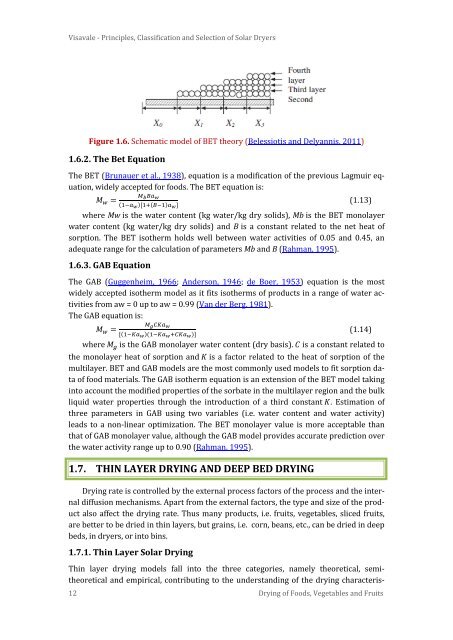Solar Drying: Fundamentals,Applications and Innovations - National ...
Solar Drying: Fundamentals,Applications and Innovations - National ...
Solar Drying: Fundamentals,Applications and Innovations - National ...
You also want an ePaper? Increase the reach of your titles
YUMPU automatically turns print PDFs into web optimized ePapers that Google loves.
Visavale - Principles, Classification <strong>and</strong> Selection of <strong>Solar</strong> Dryers<br />
Figure 1.6. Schematic model of BET theory (Belessiotis <strong>and</strong> Delyannis, 2011)<br />
1.6.2. The Bet Equation<br />
The BET (Brunauer et al., 1938), equation is a modification of the previous Lagmuir equation,<br />
widely accepted for foods. The BET equation is:<br />
M w =<br />
M b Ba w<br />
(1−a w )[1+(B−1)a w ]<br />
(1.13)<br />
where Mw is the water content (kg water/kg dry solids), Mb is the BET monolayer<br />
water content (kg water/kg dry solids) <strong>and</strong> B is a constant related to the net heat of<br />
sorption. The BET isotherm holds well between water activities of 0.05 <strong>and</strong> 0.45, an<br />
adequate range for the calculation of parameters Mb <strong>and</strong> B (Rahman, 1995).<br />
1.6.3. GAB Equation<br />
The GAB (Guggenheim, 1966; Anderson, 1946; de Boer, 1953) equation is the most<br />
widely accepted isotherm model as it fits isotherms of products in a range of water activities<br />
from aw = 0 up to aw = 0.99 (Van der Berg, 1981).<br />
The GAB equation is:<br />
M w =<br />
M g CKa w<br />
[(1−Ka w )(1−Ka w +CKa w )]<br />
(1.14)<br />
where M g is the GAB monolayer water content (dry basis). C is a constant related to<br />
the monolayer heat of sorption <strong>and</strong> K is a factor related to the heat of sorption of the<br />
multilayer. BET <strong>and</strong> GAB models are the most commonly used models to fit sorption data<br />
of food materials. The GAB isotherm equation is an extension of the BET model taking<br />
into account the modified properties of the sorbate in the multilayer region <strong>and</strong> the bulk<br />
liquid water properties through the introduction of a third constant K. Estimation of<br />
three parameters in GAB using two variables (i.e. water content <strong>and</strong> water activity)<br />
leads to a non-linear optimization. The BET monolayer value is more acceptable than<br />
that of GAB monolayer value, although the GAB model provides accurate prediction over<br />
the water activity range up to 0.90 (Rahman, 1995).<br />
1.7. THIN LAYER DRYING AND DEEP BED DRYING<br />
<strong>Drying</strong> rate is controlled by the external process factors of the process <strong>and</strong> the internal<br />
diffusion mechanisms. Apart from the external factors, the type <strong>and</strong> size of the product<br />
also affect the drying rate. Thus many products, i.e. fruits, vegetables, sliced fruits,<br />
are better to be dried in thin layers, but grains, i.e. corn, beans, etc., can be dried in deep<br />
beds, in dryers, or into bins.<br />
1.7.1. Thin Layer <strong>Solar</strong> <strong>Drying</strong><br />
Thin layer drying models fall into the three categories, namely theoretical, semitheoretical<br />
<strong>and</strong> empirical, contributing to the underst<strong>and</strong>ing of the drying characteris-<br />
12 <strong>Drying</strong> of Foods, Vegetables <strong>and</strong> Fruits

















